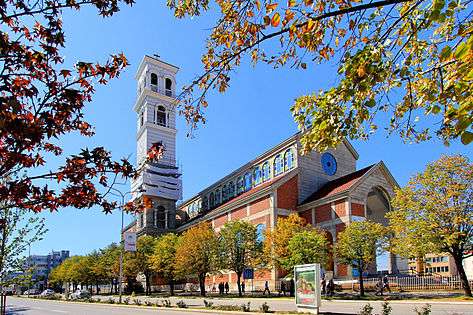Christianity in Kosovo
Christianity in Kosovo has a long-standing tradition dating to the Roman Empire. Before the Battle of Kosovo in 1389, the entire Balkan region had been Christianized by both the Roman and Byzantine Empires. Until 1389 Kosovo (Serb. Kosovo and Metohija, meaning Monastery land in greek) was center of Serbian medieval state and heart of its church life. From 1389 until 1912, Kosovo was part of the Muslim Ottoman Empire, and a high level of Islamization occurred. During the time period after World War II, Kosovo was ruled by secular socialist authorities in the Socialist Federal Republic of Yugoslavia (SFRY). During that period, Kosovars became increasingly secularized. Today, 90% of Kosovo's population are from Muslim family backgrounds, most of whom are ethnic Albanians,[1] but also including Slavic speakers (who mostly identify themselves as Gorani or Bosniaks) and Turks.
Catholic Church

About three percent of ethnic Albanians in Kosovo remain members of the Catholic Church despite centuries of Ottoman rule. During the period in which the conversion of Catholics to Islam was fastest (the second half of the sixteenth century to the end of the eighteenth century) many converts continued to practise Catholic rites in private, although the Catholic Church banned this from 1703,[2] and as late as 1845 significant numbers of people who had passed as Muslims declared themselves to be Catholics, to avoid conscription.[3] There are still reported cases of families "returning" to their Catholic faith - there are an estimated 65,000 Catholics in Kosovo and another 60,000 Kosovar born Catholics outside Kosovo.[4] Mother Teresa, whose parents were possibly from Kosovo, saw the vision which decided her upon her religious vocation at the Church of the Black Madonna at Letnica in Kosovo.[5] The central boulevard in Pristina is named after her. A Catholic Cathedral was consecrated in Pristina in 2011, having been built on land donated by the municipality. During the Kosovo war (1999), vandalisation of Kosovo Albanian Catholic churches occurred.[6] The Catholic Church of St Anthony located in Gjakova had major damage done by Yugoslav Serb soldiers.[7] In Pristina, Yugoslav Serb officers ejected nuns and a priest from the Catholic church of St. Anthony and installed aircraft radar in the steeple which resulted in NATO bombing of the church and surrounding houses.[6]
Orthodox Church
The Serb population, estimated at 50,000 to 100,000 persons, is largely Serbian Orthodox. Kosovo has 26 monasteries and many churches, Serb Orthodox churches and monasteries.[8][9][10] of which three are world Heritage Sites: the Patriarchal Monastery of Peć (although the Patriarch of the Serbian Orthodox Church has for centuries been resident elsewhere), Visoki Decani, and Gračanica. Dozens of churches were destroyed, and others damaged, after the end of Serbian governance in 1999, and a further 35 were damaged in the week of the violence in March 2004.[11]
Protestantism
There is also a small number of evangelical Protestants, whose tradition dates back to the Methodist missionaries' work centered in Bitola, in the late 19th century. They are represented by the Kosovo Protestant Evangelical Church (KPEC).[12]
See also
| Part of a series on |
| Kosovo Albanians |
|---|
| Kosovo culture |
|
Art · Cinema · Dress · Literature · Music Sport · Cuisine · Mythology |
| By region or country |
|
Kosovo · Australia · Bulgaria Croatia · Germany Greece · Italy Kosovo · Montenegro North Macedonia · Romania Serbia · Sweden Switzerland · Ukraine · United States |
| Varieties of Albanian in Kosovo |
| Gheg · Tosk · Arbëresh |
| Religion |
| Islam · Christianity · Roman Catholicism · Protestantism |
| History |
| Origins · History |
References
- "Muslims in Europe: Country guide". BBC News. 2005-12-23.
- Malcolm, Noel, Kosovo: A Short History, pp. 173-175
- Maslcolm, Noel, Kosovo: A Short History pp 186-187
- "In Kosovo, whole families return to Catholic faith" Archived 2009-02-11 at the Library of Congress Web Archives catholicnews.com 9 February 2009 Link accessed 21 March 2010
- Greene,Meg: Mother Teresa: A Biography, Greenwood Press, 2004, page 11
- Schwartz, Stephen (2000). Kosovo: Background to a War. London: Anthem Press. p. 161. ISBN 9781898855569.CS1 maint: ref=harv (link)Schwartz 2000, p. 161. " Albanian Catholic churches were also vandalized. Riedlmayer learned that Serb officers had installed anti-aircraft radar in the steeple of St. Anthony's Catholic church in Prishtina, after ejecting the priest and nuns; NATO bombing of the radar, and therefore the church and surrounding houses, would have been labelled an atrocity."
- Bevan, Robert (2007). The Destruction of Memory: Architecture at War. Reaktion books. p. 85. ISBN 9781861896384.CS1 maint: ref=harv (link) "Major damage to the Roman Catholic church of St Anthony in Gjakova, reportedly bombed by NATO, was actually committed by Serbian soldiers."
- International Crisis Group (2001-01-31). "Religion in Kosovo". Archived from the original on July 8, 2008. Retrieved 2009-07-24.
- "International Religious Freedom Report 2007 (U.S. Department of States) - Serbia (includes Kosovo)". State.gov. Retrieved 2010-04-28.
- "International Religious Freedom Report 2006 (U.S. Department of States) - Serbia and Montenegro (includes Kosovo)". State.gov. Retrieved 2010-04-28.
- United Nations High Commissioner for Refugees (2004-05-06). "Refworld | Kosovo: Nobody charged for destruction of Orthodox churches and monasteries". UNHCR. Retrieved 2009-07-20.
- Protestant Church of Kosovo web page. "Mirësevini në faqen zyrtare të Kishës Protestante Ungjillore të Kosovës". Retrieved 12 November 2010.